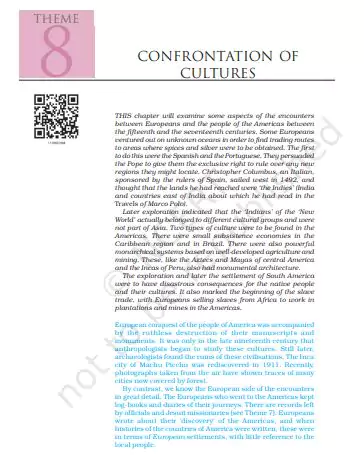‘NCERT Solutions for Class 11 History Chapter 8 Confrontation of Cultures‘ PDF Quick download link is given at the bottom of this article. You can see the PDF demo, size of the PDF, page numbers, and direct download Free PDF of ‘Ncert Class 11 History Chapter 8 Exercise Solution’ using the download button.
Confrontation of Cultures Textbook With Solution PDF Free Download

Chapter 8: Confrontation of Cultures
People have been living in North and South America and nearby islands for thousands of years, and many migrations from Asia and from the South Sea Islands have taken place over time.
South America was (and still is, in parts) densely forested and mountainous, and the Amazon, the world’s largest river, flows through miles of dense forest.
In Mexico, in central America, there were densely settled areas of habitation along the coast and in the plains, while elsewhere villages were scattered over forested areas.
The Arawakian Lucayos lived on a cluster of hundreds of small islands in the Caribbean Sea, today known as the Bahamas, and the Greater Antilles.
They had been expelled from the Lesser Antilles by the Caribs, a fierce tribe. In contrast to them, the Arawaks were a people who preferred negotiation to conflict.
Skilled boat-builders, they sailed the open sea in dugout canoes (canoes made from hollow tree trunks). They lived by hunting, fishing and agriculture, growing corn, sweet potatoes, tubers and cassava.
A central cultural value was the organization of people to produce food collectively and to feed everyone in the community. They were organized under clan elders. Polygamy was common.
The Arawaks were animists. As in many other societies, shamans played an important role as healers and intermediaries between this world and that of the supernatural.
The Arawaks used gold for ornaments but did not attach the value to the metal that the Europeans did.
They were quite happy to exchange gold for glass beads brought by the Europeans because these seemed so much more beautiful.
The art of weaving was highly developed the hammock was one of their specialities, and one which captured the imagination of the Europeans.
The Arawaks were generous and were happy to collaborate with the Spanish in their search for gold. It was when Spanish policy became brutal that they were forced to resist, but this was to have disastrous consequences for them.
Within twenty-five, years of contact with the Spanish very little remained of the Arawaks or their way of life.
People called the Tupinamba lived on the east coast of South America, and in villages in the forests (the name ‘Brazil’ is derived from the brazilwood tree).
They could not clear the dense forests for cultivation as they had no access to iron. But they had a healthy and plentiful supply of fruits, vegetables and fish, and so did not have to depend on agriculture.
The Europeans who met them envied their happy freedom, with no king, army or church to regulate their lives. In contrast to the Caribbean and Brazil, there were some highly organized states in central America.
There was a generous surplus of corn, which provided the basis for the urbanized civilizations of the Aztecs, Mayas, and Incas. The monumental architectural remains of these cities continue to mesmerize visitors today.
In the twelfth century, the Aztecs had migrated from the north into the central valley of Mexico (named after their god Mexitli).
They expanded their empire by defeating different tribes, who were forced to pay tribute. Aztec society was hierarchical. The nobility included those who were nobles by birth, priests, and others who had been awarded the rank.
The hereditary nobility were a small minority who occupied the senior positions in the government, the army and the priesthood. The nobles chose from among them a supreme leader who ruled until his death.
The king was regarded as the representative of the sun on earth. Warriors, priests and nobles were the most respected groups, but traders also enjoyed many privileges and often served the government as ambassadors and spies.
Talented artisans, physicians and wise teachers were also respected.
| Author | NCERT |
| Language | English |
| No. of Pages | 17 |
| PDF Size | 2.1 MB |
| Category | History |
| Source/Credits | ncert.nic.in |
NCERT Solutions Class 11 History Chapter 8 Confrontation of Cultures
Question 1.
What were the greatest achievements of the Mayans?
Answer:
The greatest achievements of the Mayans are as follows:
- Calendar: According to Mayan calendar, a Maya year had 365 days. The Mayans had divided the year into 18 months. Each month had 20 days. The remaining five days were regarded as unlucky by the Mayans.
- Mathematical Knowledge: The Mayans had in-depth knowledge of mathematics. They used a special sign for zero.
- Hieroglyphic Script: The Mayans made their own script. This script was a combination of pictorial signs and sounds.
- Artistic Achievements: The Mayans were efficient in architecture, painting and sculpture. They built magnificent pyramids, crossings, temples, and observations.
- Utensils made on Wheel: The Mayans used utensils made on the wheel.
Question 2.
Ghana is called the “land of gold”. Why?
Answer:
Ghana is located the northwest of the upper course of the Niger river. Ghana captured and controlled some areas of gold deposits in the 18th century. After that gold became the most important item of Ghana’s trade. That is why it is called the ‘land of gold’.
Question 3.
What were the common features of early American civilization?
Answer:
Following were the main features of early American civilization:
- In early American civilization people were more skilled in the art of stone. Their tools were made up of stones. Metals were used to make ornaments only.
- Agriculture was their main profession.
- The people of early American civilization were not familiar with cattle rearing.
- Utensils, weaving, etc. were made by the people of this civilization.
NCERT Class 11 History Textbook Chapter 8 Confrontation of Culture With Answer PDF Free Download
